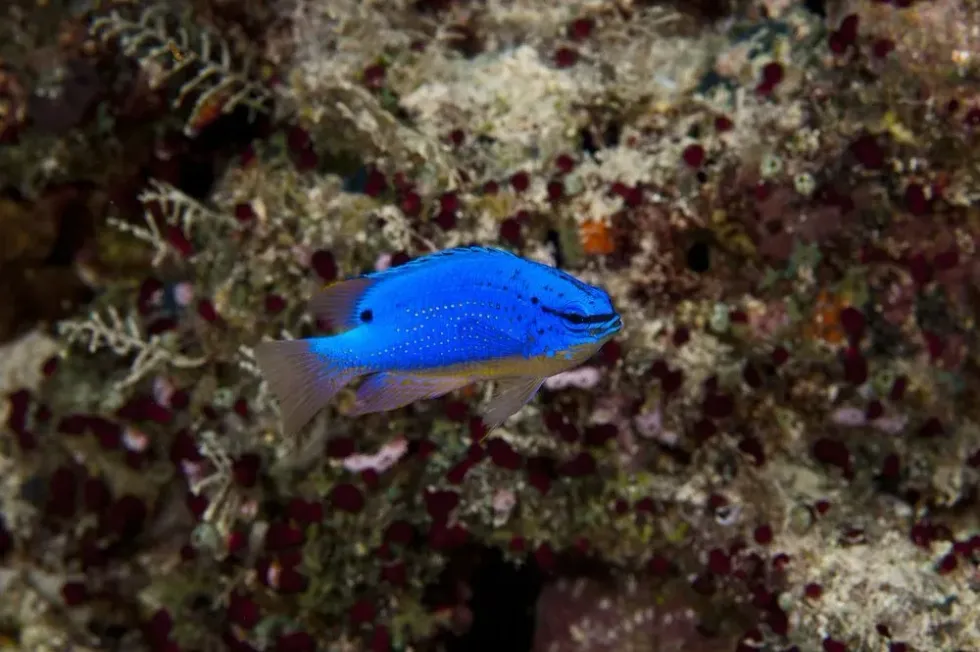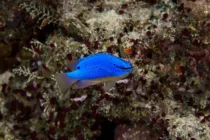The blue damselfish, or the Fiji blue devil damselfish, is an aggressive species of fish. These damselfish do not kill other fish but can bite to send a warning.
This saltwater fish loves to be in its own group of fish. They are saltwater fish that can also stay in a freshwater tank if the tank size is a minimum of 30 gal (114 l) and it has its own space.
These species can have tank mates, but this saltwater fish tends to be aggressive. You can keep a pair as tank mates, but make sure you don't have shrimps as tank mates as blue damselfish will eat them.
Their care level is easy though as long as their diet is sufficient and the water conditions are good. Since this fish is aggressive, it is also advised that their diet consists of the foods they like.
The blue damselfish's tank should consist of rocks and live coral. They are omnivores, and hence, they hunt for other small crustaceans in the tank.
It is important to have a large tank when keeping these fish as they like to mark their own territory and do not like sharing. You can keep freshwater fish that are much larger than this fish with them but make sure that there are corals so as to mimic their natural habitat which is a reef.
The males tend to show more aggression towards their territory than the females. The aquarium is a perfect area for the fish to have its territory.
To know more about some similar species, search the articles on rainbow trout and copper rockfish.
Fiji Blue Devil Damselfish Interesting Facts
What type of animal is a Fiji blue devil damselfish?
The Fiji blue devil damselfish is a fish. Its other common names include south seas. They are not really social and like to have their own personal space. They have been known to get aggressive and bite other fish that get into their territory.
What class of animal does a Fiji blue devil damselfish belong to?
The Fiji blue devil damselfish belongs to the Actinopterygii class of animals.
How many Fiji blue devil damselfish are there in the world?
The population of the Fiji blue devil damselfish is unknown. However, their lifespan increases when they are in captivity.
Where does a Fiji blue devil damselfish live?
Fiji blue devil damselfish live in the ocean, specifically in the Indo-Pacific Ocean, but through recent studies, it has been noticed that these fish survive better in captivity. A logical explanation could be that they like to have their own personal space.
They do not like other species of fish entering their space and tend to get aggressive. It would also be advised that they should not be messed with.
What is a Fiji blue devil damselfish's habitat?
Their habitat is the ocean, and to be more specific, shallow waters. They like to stay near the ocean bed and rocks as they can make their space.
A female and male can live together, but if any other species of marine animal try to enter their space, they tend to get aggressive. The temperature in which they thrive is not known.
Who do Fiji blue devil damselfish live with?
These fishes live alone as they are aggressive. As a pet, it is advised that the caretaker of the fish keeps them away from other fish as they tend to bite anything that enters their territory. In their natural habitat, they live with their own species.
How long does a Fiji blue devil damselfish live?
The lifespan of this fish is five years or longer, an exact lifespan is not known.
How do they reproduce?
The male will try and impress a female by 'dancing'. They will sway in the water to try to get the female's attention.
When the male is able to successfully get the attention of the female, it will let the female enter its territory to lay its eggs. The nest size can reach up to 10,000 eggs contributed from different female fish.
What is their conservation status?
Their conservation status is not listed in the IUCN Red List, this generally implies a stable population, not at risk of extinction.
Fiji Blue Devil Damselfish Fun Facts
What do Fiji blue devil damselfish look like?

The Fiji blue devil damselfish adaptations include its blue color with hints of yellow. The male does not have a black spot on its fin, like the female.
This fish stays in 30 gal (114 l) of water in a tank or aquarium. Since the fish likes to mark its territory, a small aquarium is not ideal. The tank or aquarium should be kept clean with coral rocks as this helps the fish live a healthier life.
How cute are they?
Just like yellow tang and Achilles tang, these marine species are cute because of their blue scales and yellow belly which makes them one of the most brightly colored fish in the sea.
How do they communicate?
They are quite similar to blue damselfish (Chrysiptera cyanea) when it comes to communication. They rub the side of other fishes and bite if they see them as a threat.
How big is a Fiji blue devil damselfish?
The Fiji blue devil damselfish is smaller than the blue devil fish. A blue devilfish is 14 in (35 cm) in size and the Fiji blue devil damselfish is 3 in (8 cm).
How fast can a Fiji blue devil damselfish swim?
There is no record of how fast a Fiji blue devil damselfish can swim.
How much does a Fiji blue devil damselfish weigh?
The weight of this fish has not been specified.
What are the male and female names of the species?
There is no sex-specific name for a male or female Fiji blue devil damselfish.
What would you call a baby Fiji blue devil damselfish?
A baby Fiji blue devil damselfish is called a fry, like babies of all other fishes.
What do they eat?
This species is omnivorous. Their diet includes meaty shrimp and saltwater algae. Their diet also includes other species found near their habitat range.
Are they dangerous?
Yes, this species of fish is dangerous as they are aggressive in nature, like clown tigerfish. It is important to practice caution when taking care of one's fish. They tend to bite humans if they try to touch them. The males show more aggression towards other saltwater species than the females.
Would they make a good pet?
The Fiji blue devil damselfish is a saltwater fish. Their care is pretty easy. They are also known as the south sea devil because of their aggressive temperament.
This is not to be confused with the blue damselfish as that is a saltwater fish as well. This fish doesn't like to have tank mates, but if you want to keep tank mates, make sure that the aquarium can hold at least 30 gal (114 l) of water.
The water conditions of the tank or aquarium must be checked.
The tank or aquarium can have different species of fish, but this species of fish will eat any shrimp that are present in the aquarium as they are a part of their diet. They like to mark their territory and do not like any other species of fish to enter that territory.
The same applies when they are kept in an aquarium.
Did you know...
Unlike most damselfish, the orangetail damselfish is the least aggressive and one of the most peaceful of the damselfish species.
How did the Fiji blue devil damselfish get its name?
The Fiji blue devil damselfish got their name because of their aggressive personality and the 'blue' part of the name comes from their bright blue scales. The males tend to show more aggression towards other fish. They tend to bite other fish due to their aggressive temperament.
Are Fiji blue devil damselfish Endangered?
The Fiji blue devil damselfish is not endangered but tends to thrive in an aquarium or tank. When taking care of these fish, you have to make sure that the aquarium mimics their habitat.
Here at Kidadl, we have carefully created lots of interesting family-friendly animal facts for everyone to discover! Learn more about some other fish from our African lungfish facts or ocean sunfish facts pages.
You can even occupy yourself at home by coloring in one of our free printable fish coloring pages.







